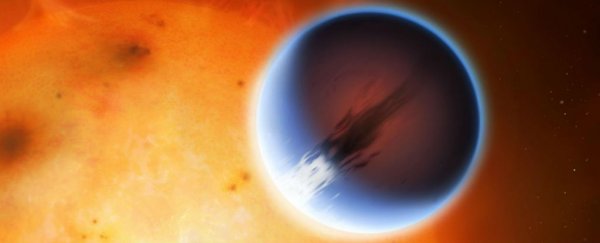A recent investigation into the conditions on exoplanet HD 189733b, located 63 light-years away in the constellation Vulpecula, has identified winds tearing around it at speeds of over 8,690 km/h (5,400 mph). That's more than 2 km per second, which is 20 times the fastest winds ever recorded on Earth, 3.5 times the fastest winds recorded in the Solar System, and seven times the speed of sound.
This is the first time that scientists have been able to directly measure and map the weather of a planet outside our Solar System, and the team behind the discovery says the technique can be used on other distant planets as we search for conditions that could potentially sustain life.
"This is the first ever weather map from outside of our Solar System," said lead researcher Tom Louden from the University of Warwick in the UK. "Whilst we have previously known of wind on exoplanets, we have never before been able to directly measure and map a weather system."
While HD 189733b might be the first distant planet to have its weather mapped, it's about the last place we'd consider investigating for signs of life. If those 8,690 km/h winds aren't enough to deal with, it's consistently serving up temperatures of more than 1,800 degrees Celsius, which is almost twice as hot as the centre of the Earth.
That extreme heat puts HD 189733b in a very common class of planets known as 'hot Jupiters' (or our favourite nickname: 'roaster planets'), so-called because while they're similar in size, mass, and composition to Jupiter, they orbit super close to their parent star, which has resulted in some insane surface temperatures. The hottest known planet - hot Jupiter WASP-33b - maintains surface temperatures of over 3,315 degrees.
"[T]hey hang out at stellar distances typically between 0.015 to 0.15 AU (1 AU = average distance from Earth to the Sun). This is really, really close to the parent star," says George Dvorsky at io9. "For comparison, Mercury orbits at 0.39 AU. And in fact, hot Jupiters are so close that their orbits are practically circular."
In the past, weather conditions on hot Jupiters and other distant planets have been estimated indirectly by looking at the infrared brightness reflected by the surface at certain times of the year. Instead, Louden and his team used HARPS, (High Accuracy Radial velocity Planet Searcher) in Chile to make a weather model based on direct observational evidence of how the planet's wind influences sodium emissions in its atmosphere.
They used a phenomenon known as the Doppler effect - a change in the frequency or wavelength of a sound wave according to something that's moving relative to the source - to figure out how quickly the winds were moving from the day side of the planet to its night side.
"As parts of HD 189733b's atmosphere move towards or away from Earth, the Doppler effect changes the wavelength of this feature, which allows the velocity to be measured," says Louden. "For the first time we've used this information to measure the velocities on opposite sides of the planet independently, which gives us our velocity map."
Right now, the technique would probably only work on very large planets like hot Jupiters, and that's not great if we want to start mapping the weather of distant Earth-like planets to identify the best candidates for life. This is because hot Jupiters are enormous - Jupiter itself is 2.5 times more massive than all the rest of the planets in the Solar System combined, and HD 189733b is 10 percent more massive than that.
The team is now working on adjusting the technique so it can be applied to much smaller planets - hopefully planets with much gentler winds and kinder surface temperatures.
The results have been published in The Astronomical Journal Letters.
